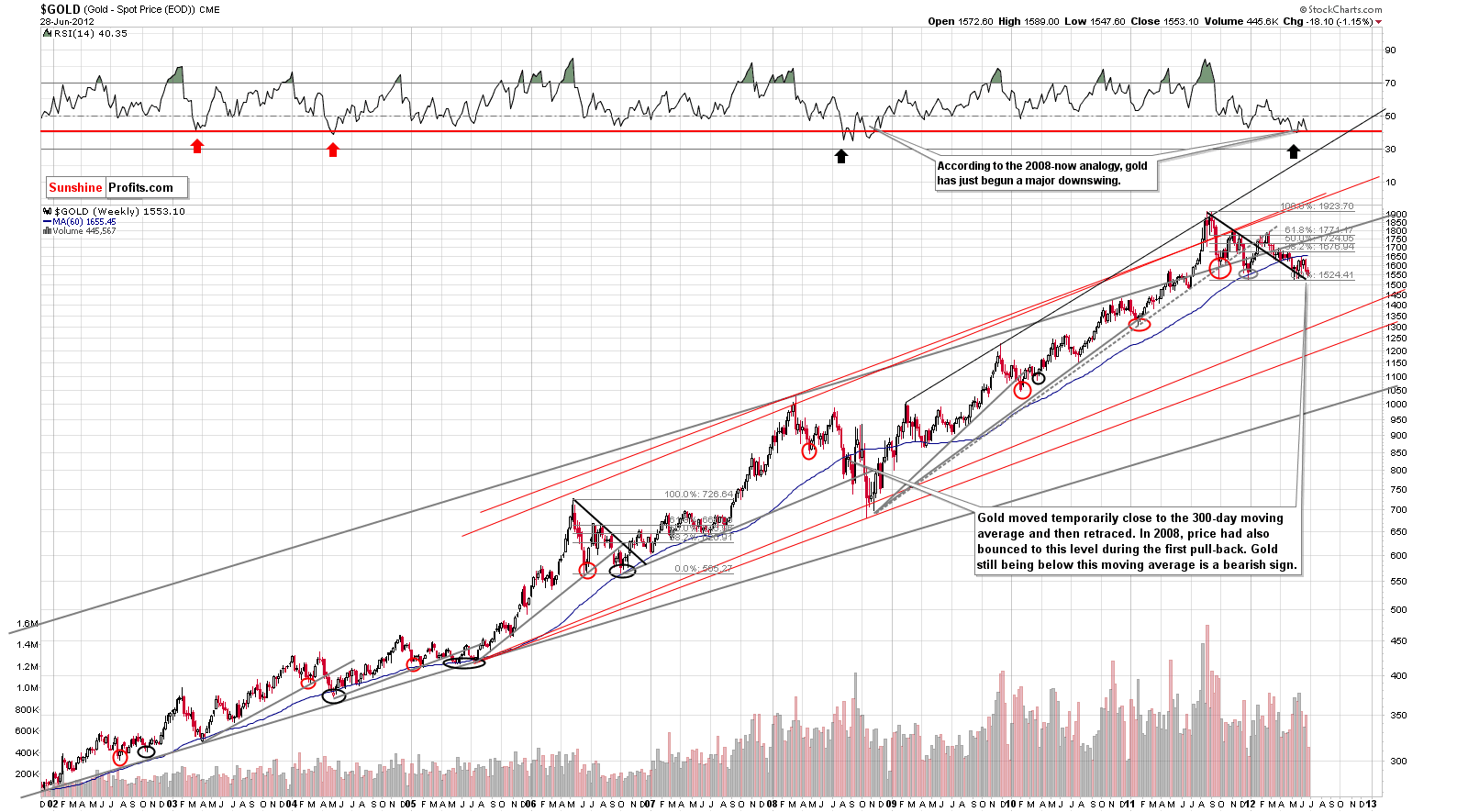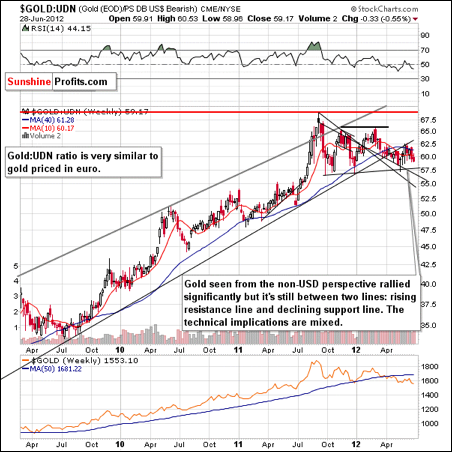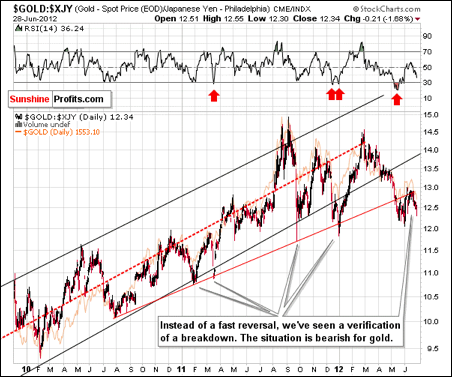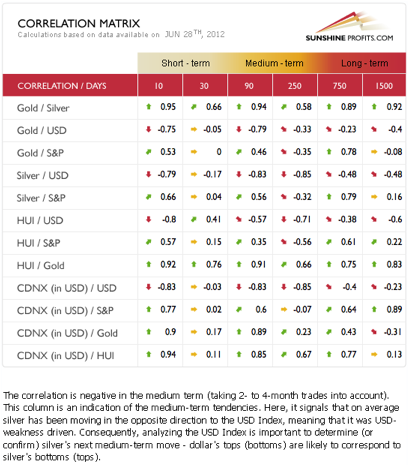Visit our archives for more gold & silver articles.
Let's start by stating that the title of this essay refers to the current situation on the gold market ? not to the long-term fundamental picture. In fact, up to this day, no paper currency has survived in its original form while gold has been used as money since time immemorial. Every fiat currency since Roman times has ended in devaluation and eventual collapse, of not only the currency, but often of the host economy. The usual course of events is that paper currencies are inflated away until worthless. The purchasing power of the US dollar, for example, has declined by 90% since 1950, also true for most currencies.
The Roman Denarius was a coin of pure silver at the beginning of the first century C.E. Hundred years later the denarius'? silver content was down to 85%. Roman emperors liked the idea of devaluing their currency in order to pay the bills and by 218 C.E. the Denarius was down to 43% silver. Around the time of the collapse of the Romans Empire, the Denarius contained only 0.02% silver and was no longer universally accepted as a medium of exchange or a store of value.
There are numerous other examples of failed experiences in fiat money, the ?"Flying Money"? of China, The Livres and Assignats of France. The German Mark under the Weimar republic deserves special mention, since this period influences Germany?s thinking today. Post-World War I Weimar Germany is infamous as an example of the greatest hyperinflation ever. The Treaty of Versailles that ended World War I punished Germany by forcing it to make reparations. The only way Germany could meet its obligations was by running the printing press. Inflation got so bad that Germans were using stacks of Marks to heat their furnaces and used wagon loads to buy bread. In 1919, 12 German marks equaled one U.S. dollar. By 1923 the rate was 4.2 trillion marks for one U.S. dollar. In more recent history we have had currency shocks in Argentina, Finland, Italy, Norway, Mexico, Thailand, Russia, Turkey and there are many more examples.
So what?'s in the future for the dollar?
History teaches us that when governments come under financial pressure they can never resist printing money to pay for debts, be it for wars or excessive spending. Gold is the only currency which has no liability attached to it, nor can it be printed, counterfeited or reproduced (well, silver and platinum are exceptions here). Among its many stellar qualities is the fact that it cannot be destroyed by fire, water or time. Gold doesn't expire, it is mobile, divisible and internationally accepted for the last few thousands of years.
Over time gold has represented an excellent investment that holds it value in real terms. In particular, gold appreciates during periods of high inflation and financial instability. As there is limited supply of gold it cannot be printed to finance government deficit spending. Gold can act as a critical hedge both against inflation and a deflationary financial collapse.
Precious metals are in a secular bull market and are likely to move much higher eventually, but there?'s a huge difference between ?eventually? and ?now? and a decline may be seen first.
So, let's begin this week's technical part with the analysis of gold itself (charts courtesy by http://stockcharts.com.)

In the very long-term gold chart (if you are reading this essay on sunshineprofits.com, you may click the above chart to enlarge), not many changes were seen last week although we do see RSI levels suggesting the situation is similar to 2008. Indications are that a significant decline is underway right now, and it'?s likely that the period ahead will be quite volatile.
We expect volatility, especially if gold?'s price moves below the $1,500 level. This would be an important development, because it would surpass the two recent local bottoms and the psychological round number of $1,500. Many would likely run for the hills causing the decline to accelerate.
Now, let'?s have a look at gold from a non-USD perspective.

In this chart, we see no significant changes. Price levels remain between the rising resistance and declining support lines as has been the case for a number of weeks now. The recent sideways trading patterns continue to have mixed implications.
To complete the currency-based gold analysis, let's have a look at gold-to-Japanese yen ratio which really is the price of gold seen from the perspective of those who use yen to pay their bills...

Looking at gold from the Japanese yen perspective, it appears that the breakdown below the red support line has been verified, and this line will now provide resistance to any turnaround in prices here. The medium-term trend is to the downside, and the outlook remains bearish here.
To finish off, let's take a look at precious metals correlations.

The Correlation Matrix is a tool, which we have developed to analyze the impact of the currency markets and the general stock market upon the precious metals sector. Last week, the short-term correlations appeared rather weak. Metals did not respond immediately to all the signals from the currency and general stock markets and price moves generally were somewhat erratic.
The medium-term coefficients of the precious metals last week held pretty much true to form as they were negative with the USD Index and positive with the general stock market. The currency markets continued to be more important at this time as has been the case for the past month or so. This is true although not really visible on a day-to-day basis. So let us stress a thing that we mentioned many times in the last couple of weeks: significant moves to the upside in the USD Index are likely to be devastating to precious metals prices.
Summing up, the short-term outlook for gold is not bullish. As for correlations, currencies currently seem to be the most influential factors responsible for gold and other precious metals recent moves, and every precious metals investor should watch these markets carefully. There will be time to get back on the golden boat and it might come soon if signals from the above charts are invalidated. This is definitely not a good time to stop paying attention to the developments on the precious metals market.
To make sure that you are notified once the new features are implemented, and get immediate access to my free thoughts on the market, including information not available publicly, we urge you to sign up for our free e-mail list. Gold & Silver Investors should definitely join us today and additionally get free, 7-day access to the Premium Sections on our website, including valuable tools and unique charts. It's free and you may unsubscribe at any time.
Thank you for reading. Have a great weekend and profitable week!
P. Radomski
--
Times are critical on the gold market as on one hand dollar is moving higher, but on the other hand gold managed to move higher in the past 2 days as well. That's why we sent out 2 Market Alerts since posting our latest Premium Update - we suggest that you join us and read them right away.

